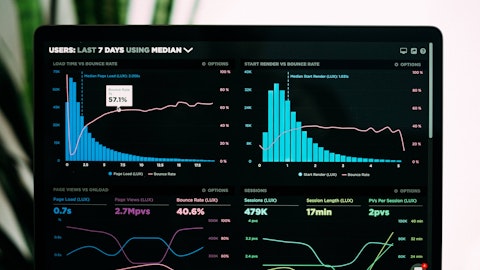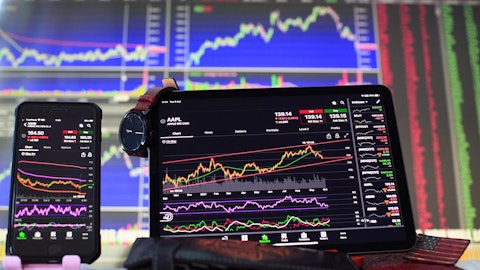In this piece, we will take a look at the 12 best growth ETFs to buy. If you want to skip our analysis of the latest bit of news about the stock market, then check out 5 Best Growth ETFs to Buy.
September is proving to be a crucial month for the stock market in the wake of the Federal Reserve’s latest monetary policy meeting. The central bank has been increasing interest rates for more than a year now, and its latest gathering saw policymakers choose a pause but hint that rates will remain higher for longer than initially expected. This stance was expected given that the U.S. economy has surprised analysts and managed to grow and the recent rise in crude oil prices is creating worries that inflation might rise again or become tougher to curtail – requiring the Fed to increase rates even more.
However, the latest decision to skip a rate hike cements the fact that even though more interest rate increases might be in store and the Fed might not reduce them as strongly as some expect, the ‘terror’ era of 2022 that saw consecutive 75 basis point hikes is over. Yet, markets are still sensitive to the central bank’s decision since the current investment climate of benchmark rates being higher than 5% is quite different from what investors have been accustomed to as of late. So any whiff of high rates tends to make stock market investors uneasy and this was also the outcome after the latest interest rate decision.
The key data set that accompanied the latest Fed gathering is its Summary Economic Projections (SEP) and the dot plot that lays down the course of hikes for the remainder of this year. This data shows that policy makers expect to raise rates by 25 basis points one more time in 2023 and reduce rates by 50 basis points next year. On the inflationary front, the central bank also expects inflation to drop to 3.2% by the end of this year, indicating that the policy shocks that the world and investors have had to deal with were fruitful.
Shifting towards markets, naturally, stocks all across the board were down. The S&P500 started slipping soon after the data was released and closed the day 41.75 points or 0.94% lower. The tech heavy NASDAQ 100 and the broader NASDAQ Composite indexes were down 1.46% and 1.53%, respectively, while the flagship Dow Jones Industrial Average (DJIA) or the blue chip stock index closed the day by dropping 0.22%. On the other side of the pond, global reverberations of U.S. monetary policy were felt as the British FTSE 100 and FTSE 250 Midcap indexes fell by 0.4% each.
However, it’s not all gloom and doom after the latest data release from the central bank. One of the most widely talked about impacts of rapid and large interest rate hikes is a recession. Technically defined as an economic slowdown over two consecutive quarters, a recession occurs after high rates because businesses and consumers find it harder to secure credit to manage their operations or make purchases large and small. In the customary press conference that follows a monetary policy decision, the man of the hour, Fed Chairman Mr. Jerome Powell shared that while the Fed expects elevated inflation to last until 2025, a strong economy and job market will provide the Fed with more leeway to keep the pressure up on the economy.
GDP was also on Chair Powell’s mind, as he outlined during the press talk:
Recent indicators suggest that economic activity has been expanding at a solid pace. And so far this year, growth in real GDP has come in above expectations. Recent readings on consumer spending have been particularly robust. Activity in the housing sector has picked up somewhat, though it remains well below levels of a year ago, largely reflecting higher mortgage rates. Higher interest rates also appear to be weighing on business fixed investment. In our Summary of Economic Projections, or SEP, committee participants revised up their assessments of real GDP growth with the median for this year now at 2.1 percent. Participants expect growth to cool with the median projection falling to 1.5 percent next year.
The labor market remains tight, but supply and demand conditions continue to come into better balance. Over the past three months, payroll job gains averaged a hundred and fifty thousand jobs per month, a strong pace that is nevertheless well below that seen earlier in the year. The unemployment rate ticked up in August but remains low at 3.8 percent. The labor force participation rate has moved up since late last year, particularly for individuals aged 25 to 54 years. Nominal wage growth has shown some signs of easing and job vacancies have declined so far this year. Although the jobs-to-workers gap has narrowed, labor demand still exceeds the supply of available workers.
These turbulent times in the stock market, especially the second half of 2023 which has done away with the earlier euphoria can mean that stock valuations are lower than what their fundamentals might merit. As a consequence, we decided to take a look at some top growth ETFs with the notable picks being Vanguard Mega Cap Growth Index Fund (NYSE:MGK), Invesco QQQ Trust (NASDAQ:QQQ), and Schwab U.S. Large-Cap Growth ETF (NYSE:SCHG). If you are interested in individual stocks, please take a look at our article about the 14 Low Risk High Growth Stocks to Buy.

Photo by Karolina Grabowska from Pexels
Our Methodology
To compile our list of the best growth ETFs, we first compiled a list of the 20 largest small, mid, and large cap growth funds as categorized by Morningstar Financial. Then, their five year annualized returns were determined and the top 12 growth ETFs are as follows.
12 Best Growth ETFs to Buy
12. iShares S&P Mid-Cap 400 Growth ETF (NYSE:IJK)
5 Yr. Annualized Return: 5.79
iShares S&P Mid-Cap 400 Growth ETF (NYSE:IJK) is part of the iShares fund family. It was set up in 2000 and has net assets worth $7.5 billion. The ETF tracks the S&P MidCap Growth Index, and it has 254 holdings. A growth ETF, the iShares S&P Mid-Cap 400 Growth ETF (NYSE:IJK)’s P/E ratio is 15.11. The fund’s top three holdings are Hubbell Incorporated (NYSE:HUBB), Builders FirstSource, Inc. (NYSE:BLDR), and Reliance Steel & Aluminum Co. (NYSE:RS). The ETF joins Invesco QQQ Trust (NASDAQ:QQQ), Vanguard Mega Cap Growth Index Fund (NYSE:MGK), and Schwab U.S. Large-Cap Growth ETF (NYSE:SCHG) in our list of the best growth ETFs.
11. SPDR S&P 400 Mid Cap Growth ETF (NYSE:MDYG)
5 Yr. Annualized Return: 5.85%
SPDR S&P 400 Mid Cap Growth ETF (NYSE:MDYG) is another ETF that tracks the S&P MidCap Growth Index. It was set up in 2005 and has $1.8 billion in net assets, making it one of the smaller funds on our list. The ETF has a price to earnings ratio of 15.01, and it is part of the SPDR State Street Global Advisors Fund Family. Like the iShares S&P Mid-Cap 400 Growth ETF, the top three holdings of the SPDR S&P 400 Mid Cap Growth ETF (NYSE:MDYG) are also Hubbell Incorporated (NYSE:HUBB), Builders FirstSource, Inc. (NYSE:BLDR), and Reliance Steel & Aluminum Co. (NYSE:RS).
10. iShares Russell Mid-Cap Growth ETF (NYSE:IWP)
5 Yr. Annualized Return: 7.24%
iShares Russell Mid-Cap Growth ETF (NYSE:IWP) is another iShares fund family ETF. It was set up in 2001 and has net assets of $12.6 billion. The ETF, as its title suggests, tracks the Russell MidCap Growth Index. It also has a higher price to earnings ratio than some other funds on our list, since the metric currently sits at 28.83. The price to book ratio is also a rather high 8.53. More than half of the iShares Russell Mid-Cap Growth ETF (NYSE:IWP)’s holdings are concentrated in the information technology, healthcare, and industrial sectors.
9. iShares Morningstar Mid-Cap Growth ETF (NYSE:IMCG)
5 Yr. Annualized Return: 8.98%
iShares Morningstar Mid-Cap Growth ETF (NYSE:IMCG) is an iShares ETF that tracks the Morningstar US Mid Cap Broad Growth Index. It has net assets of $1.5 billion and was set up in 2004. The ETF’s price to earnings ratio is 26.88 and its top three holdings are Workday, Inc. (NASDAQ:WDAY), TransDigm Group Incorporated (NYSE:TDG), and Marvell Technology, Inc. (NASDAQ:MRVL).
8. Invesco S&P MidCap Momentum ETF (NYSE:XMMO)
5 Yr. Annualized Return: 9.50%
Invesco S&P MidCap Momentum ETF (NYSE:XMMO) is part of the Invesco funds family. Set up in 2005, it is one of the smallest funds on our list with net assets of $1.5 billion. The ETF seeks to add the benefits of investing in momentum stocks along with growth stocks, as it tracks the S&P Midcap 400 Momentum Index. The fund’s portfolio is heavily tilted towards industrial firms, which represent close to 40% of its investments.
7. iShares S&P 500 Growth ETF (NYSE:IVW)
5 Yr. Annualized Return: 11.24%
iShares S&P 500 Growth ETF (NYSE:IVW) is a top tier growth ETF since it tracks the S&P 500 Growth Index which is a collection of the premium stocks on the S&P500 in growth terms. The ETF is also quite sizeable since it holds $34.5 billion in net assets. It has a P/E ratio of 24.15 and has invested in 236 holdings.
6. SPDR Portfolio S&P 500 Growth ETF (NYSE:SPYG)
5 Yr. Annualized Return: 11.40%
The SPDR Portfolio S&P 500 Growth ETF (NYSE:SPYG) also tracks the S&P500 growth index. It has $18.8 billion in assets under management, and has piled the funds into 236 holdings. The SPDR Portfolio S&P 500 Growth ETF (NYSE:SPYG)’s top three holdings are made of some of the most well known growth companies in the world, such as Apple Inc. (NASDAQ:AAPL) and Microsoft Corporation (NASDAQ:MSFT).
Vanguard Mega Cap Growth Index Fund (NYSE:MGK), SPDR Portfolio S&P 500 Growth ETF (NYSE:SPYG), Invesco QQQ Trust (NASDAQ:QQQ), and Schwab U.S. Large-Cap Growth ETF (NYSE:SCHG) are some top growth ETFs with strong returns.
Click to continue reading and see 5 Best Growth ETFs to Buy.
Suggested articles:
- 10 Tech Stocks Benefiting From The AI Boom
- 10 Best Performing Growth ETFs in 2023
- 10 Best GARP Stocks That Pay Dividends
Disclosure: None. 12 Best Growth ETFs to Buy is originally published on Insider Monkey.


